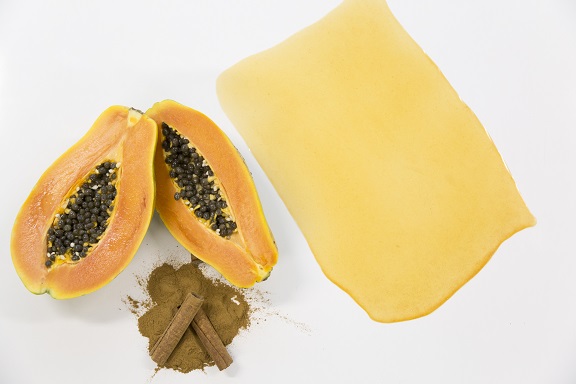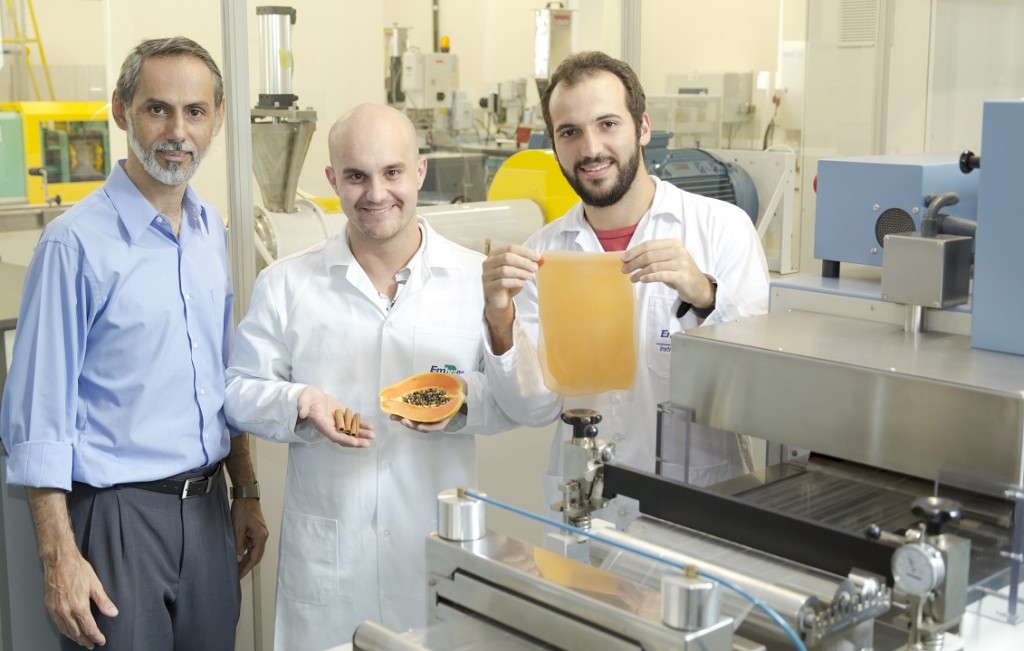The scientific paper by members of the Brazilian community on Materials research featured this month is:
Caio G. Otoni, Márcia R. de Moura, Fauze A. Aouada, Geany P. Camilloto, Renato S. Cruz, Marcos V. Lorevice, Nilda de F.F. Soares, Luiz H.C. Mattoso. Antimicrobial and physical-mechanical properties of pectin/papaya puree/cinnamaldehyde nanoemulsion edible composite films. Food Hydrocolloids. Volume 41, December 2014, Pages 188–194. DOI: 10.1016/j.foodhyd.2014.04.013.
Papaya and cinnamon: ingredients in antimicrobial films for food packaging.

Edible packagings are films that may be eaten without harming one’s health. They may be used to wrap food in order to protect it, to improve its appearance or to provide some texture or flavor. Such films already are on the markets, replacing animal tissue in cold meats or seaweeds in sushi, just to name a few uses.
Besides being interesting under an environmental perspective, as they may use wasted residues from fruit and vegetables in their composition, they are even more attractive when provided with antimicrobial properties, because it allows the decrease in the amount of preservatives in the food they wrap.
In Brazil, a team comprising materials engineers, chemists and food engineers has produced edible films with antimicrobial properties, based on renewable sources: pectin, papaya and cinnamon essential oil.
The project was developed in three main stages. The first one was performed at the National Nanotechnology Laboratory for the Agribusiness in the instrumentation unit of Embrapa (the Brazilian Agricultural Research Corporation) and consisted in obtaining and characterizing nanoemulsions of cinnamaldehyde, the main component in the cinnamon essential oil. Using mechanical stirring in a controlled way, with several speeds, the researchers obtained emulsions with cinnamaldehyde particles of different sizes, from 20 to 500 nm of diameter.
For the second stage, also conducted at Embrapa Instrumentation, the researchers produced films based on pectin (a natural polymer found in plant tissues and known for its gelling capacities), added with papaya puree and the obtained emulsions. Finally, the team characterized the films. Their mechanical and antimicrobial properties were analyzed at the Packaging Laboratory of the Federal University of Viçosa, UFV, in Minas Gerais State, while their properties as a water barrier were assessed at Embrapa Instrumentation. Professors from the State University of Feira de Santana in Bahia State and São Paulo State University, UNESP, performing at that moment their postdoctoral researches at Embrapa and UFV’s laboratories contributed to the project as well.
The results of their studies were recently published by the journal Food Hydrocolloids.
The films
Incorporating cinnamaldehyde nanoemulsions to the films inhibited the development of four pathogenic bacteria tested by the team of researchers (Escherichia coli, Salmonella enterica, Listeria monocytogenes and Staphylococcus aureus).
“The most interesting result is that decreasing the size of the nanoemulsions particles notably potentiated the inhibitory activity of the films”, highlights Caio Otoni, main author of the paper, Master’s student in Materials Science and Engineering at the Federal University of São Carlos, UFSCar. “That may impact the use of polymeric packaging with antimicrobial capacites for wrapping food, considering that the same food security guaranteed by the active packaging may be obtained using lower amounts of preservatives, if encapsulated in smaller particles, which is an advantage for manufacturers (lower production costs) and consumers (ingestion of less preservatives)”, concludes Caio, who developed the project with other seven authors, while attending the Food Engineering undergraduate course at UFV.
In addition to providing antibacterial properties to the films, the nanoemulsions made them less permeable to humidity and less plastic (more rigid and less extensible). On the other hand, the papaya pulp caused an inverse effect, concerning those attributes.

